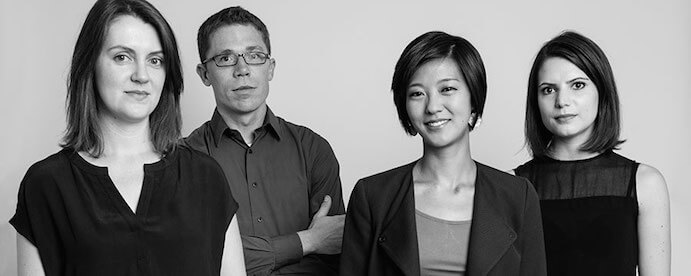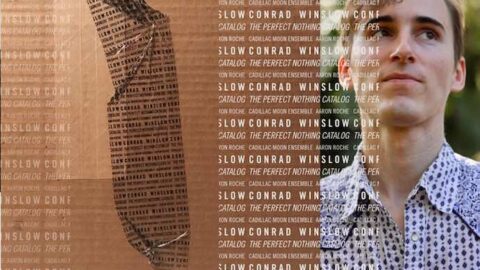The Perfect Nothing Catalog is the debut CD by Brooklyn based composer Conrad Winslow. Scheduled for a November 17th on Innova Recordings, this ambitious project features the esteemed Cadillac Moon Ensemble performing four of Winslow’s most recent works. To mark this event, Cadillac Moon and guitarist Aaron Roche will perform selections from the album on November 16th in New York City’s 1 Rivington Space. Winslow’s music has been commissioned by groups as diverse as Alarm will Sound, the Albany Symphony Orchestra and the Aspen Music Festival. His compositions have been described as “compelling” by the New York Times and “a scenic, boisterous and bumpy ride” by the Albany, NY Times-Union, making this recording one of the “must hear” selections of the season. ICIYL caught up with Winslow recently and asked 5 questions about the CD’s title work, The Perfect Nothing Catalog, and the thought and inspiration behind the project.
The album’s title work The Perfect Nothing Catalog is a rather substantial piece of about 30 minutes. What was the inspiration behind this composition?
It was two-fold: one was a play by the amazing British playwright Caryl Churchill made of short non-developing scenes, and the other was an ongoing series of installation projects by my friend Frank Traynor. I was thinking a lot about how to use seemingly-worthless-but-maybe-
Cadillac Moon Ensemble has performed The Perfect Nothing Catalog several times live in concert, but this performance is different. Can you tell us how this particular performance came about?
I love thinking about musical expression as masquerade. And I always felt that the piece would thrive in dialog with overlapping electronic layers. So I worked with Aaron Roche to laminate the acoustic piece with a bunch of passes of electronic effects, and then edited and mixed extensively with these new layers. Dealing with expression in music as a series of masks over masks—especially now—can reveal a lot of about what we take as real, as contrived, as polished, and as raw.
Three of your other compositions round out the CD. Can you give us a glimpse of those works?
Sean Statser, the founding percussionist of Cadillac Moon Ensemble, approached me a couple years ago about putting together a record our collaborations. Abiding Shapes (2012) was my first commission from the group, which turned out to be a formal precursor to the Catalog. Then, Sean commissioned me to write Ellipsis Rules (2014), a resonance etude for vibraphone. And finally I wrote the Catalog for the group in 2014. All of these pieces are now joined by similar layers of audio production, developed with Aaron Roche. And Ellipsis Rules, although it’s a solo for Sean, features samples of the other members of the ensemble speaking in the studio in between takes. So everyone is present throughout the album. The last track, Benediction, is my little thanksgiving card to all the musicians involved.

Cadillac Moon Ensemble’s combination of instruments, flute, violin, cello, and percussion is a somewhat unusual. Do you find writing for a unique ensemble is restrictive, or does it open up new possibilities for a composer?
Having a percussionist in a mixed quartet may suggest a certain way of thinking: you can have a lyrical group and a rhythmic group, or a soloist + rhythm section, for instance. Or you could just blend them all into a hazy texture. I loved balancing variety and cohesion within this instrumentation. Roberta Michel has a beautiful tone on all four of her instruments (bass, alto, C flute, and piccolo), so she opens a lot of possibilities within the ensemble. Sean, in addition to having great technique generally, is a superb mallet player, so the ensemble can really sing. And Karen and Mindy are wonderful musicians who are also game to do weird things like make choreographed stomping sounds and play velcro with complete refinement.
Although you are based in Brooklyn now, you grew up in a small town in Alaska. Did growing up in Alaska influence your music in anyway?
Yes, probably in the way that I convince (delude?) myself that I can always start from scratch. It’s a super West-Coast mentality. My parents literally built a log cabin from the woods. I spent a lot of time hiking, fishing for salmon, halibut, and herring with my dad, drawing ocean-scapes and mountain-scapes. Imagine growing up seeing Bob Ross landscapes everywhere. I remember pointing to maps in my dad’s fishing boat and asking if anyone had ever stepped on that exact place. Was there anything left to explore?
I think the whole experience of first contact with nature—not dealing with centuries of human efforts and wars and counter-reactions—influences my approach to sound in general and structural problems in particular. I just picked up a beautiful photobook by Marie-José Jongerius and Hans Gremmen, Edges of the Experiment, that meditates on the creation of landscapes in the American West. You sense the range of fantasies that people express by carving landscapes out of the desert and mountains of the West—for good and for bad. That’s still happening up North, although with (arguably) more environmental awareness.
























